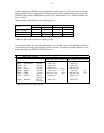-17-
TIE LINES:
Transferring Calls
The MERLIN LEGEND CS supports trunk calls that come into the system and go out on another trunk
without any operator assistance.
However, the transmission code in the system does not permit multiple
hops, and there is no automatic routing system which can be used for tandem trunking.
Never-the-less, with the LEGEND system it is very easy to transfer your calls over a tie line to another
PBX. Whether the call you are on is a local line or a tie line call, the procedure is the same.
When you want to transfer a tie/local call begin by touching the Transfer button. This will give you dial
tone.
Dial the tie line access code to connect to another switch. (For the sake of this example, let’s say it’s a
Chicago switch.) When you hear dial tone, then dial the number of the extension in Chicago.
When the ringing tone is heard, complete the consultation transfer where you alert the called party that a
transfer is being made by remaining on the line until they answer. Alternatively, you can complete the
transfer by hanging up your station once the called station begins to ring; the transfer is completed
automatically y. If the called party does not answer after you’ve gone on-hook, then Transfer Return will
return the call to your station if the call is within your system.
If the user on the LEGEND system attempts to make another trunk-to-trunk transfer on the Chicago switch,
or to dial a local Chicago outside number, this would constitute a second or multiple hop. It is this type of
multiple hop the the LEGEND) system transmission code does not recognize, and the system does not
support.
.
TIE TRUNKS:
Signaling and Implementation
The PBXs that terminate the tie trunk must be optioned to work in a compatible manner (for instance, to
use tone or rotary dial pulse signaling), and the facilities must be engineered so they pass transparently
through any central office.
The LEGEND system is administered for the appropriate tie trunk operation when the smite is installed.
Tie trunks may use immediate start or wink-start operation, as described under DID trunks. Tie trunks may
also provide automatic operation. With automatic operation no start dial signals are used. The seizure
signal alone is sufficient to route the call to a predetermined destination. The call destination is determined
when the trunk group is administered, and is usually the attendant.
In addition, a signaling format must be specified. Unlike loop-start, ground-start, and DID trunks, tie
trunks may use special leads for signaling. These leads are called “E” (for “Ear”) and “M” (for “Mouth”),
and the system is referred to as “E&M lead signaling.”
The “M” (Mouth) lead sends signals from the
switching equipment to the signaling equipment, and the “E” (Ear) lead listens for signals from the
signaling equipment and carries them to the switching equipment. A signal from the local system to the
distant system leaves on the “M” lead of the local system and arrives on the “E” lead of the remote system.
If E&M leads are not used the tie trunk is referred to as being “Simplex.”


















